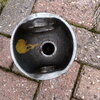- Posts
- 7,900
- Location
- East Midlands
I thought I'd post a few pictures of what I'm up to in the Land Rover. I've said elsewhere that I'm doing the swivel balls and brakes, so in between the showers this morning I made a start. In the immortal words of Mr Haynes 'jack up the car and remove the road wheels'.

I've got the steering linkages off and brake pads out in that picture too. The brake caliper bolts came out straight away. The seals seem to be coming loose so maybe it was a good idea to do this now:

You can see there that rarest and best travelled representative of Solihull wildlife, the brake caliper spider. The door mirror spider tends to get blown off on motorway journeys, but this little fellow snuggles in between the brake and the hub casing and is safe from everything except heavy wading.
The swivel bearings went into the new ball uneventfully - here it is going back together:
 And back on the axle:
And back on the axle:
 There's a little slack on the driveshafts and CV joint but I think it can go back in for another round. Mr Britannica restorations on Youtube put one with more slack than mine back in a customer's Land Rover, so it should be alright.
There's a little slack on the driveshafts and CV joint but I think it can go back in for another round. Mr Britannica restorations on Youtube put one with more slack than mine back in a customer's Land Rover, so it should be alright.
I've now got the problem that others on here have mentioned that when the stub axle is fully tightened something's binding and I don't have the full range of steering movement.The witness marks suggest that the CV cup is fouling the inside of the new ball. I'll have to take it all to bits again and try and grind a bit out. What I really need for this job is a die grinder but all I have to hand is a little dremel-y thingy. I'll see how much metal I can shift with it. I'm having a break just now and lunching on samosas but I'll go out and have another go shortly.
I've got the steering linkages off and brake pads out in that picture too. The brake caliper bolts came out straight away. The seals seem to be coming loose so maybe it was a good idea to do this now:
You can see there that rarest and best travelled representative of Solihull wildlife, the brake caliper spider. The door mirror spider tends to get blown off on motorway journeys, but this little fellow snuggles in between the brake and the hub casing and is safe from everything except heavy wading.
The swivel bearings went into the new ball uneventfully - here it is going back together:
I've now got the problem that others on here have mentioned that when the stub axle is fully tightened something's binding and I don't have the full range of steering movement.The witness marks suggest that the CV cup is fouling the inside of the new ball. I'll have to take it all to bits again and try and grind a bit out. What I really need for this job is a die grinder but all I have to hand is a little dremel-y thingy. I'll see how much metal I can shift with it. I'm having a break just now and lunching on samosas but I'll go out and have another go shortly.
Last edited:

